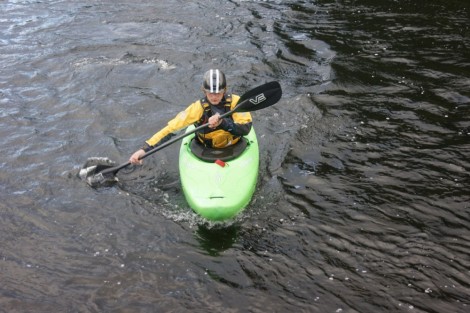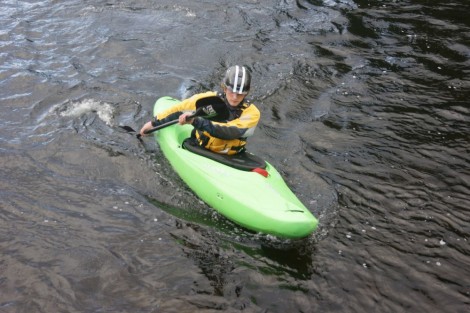Early Success
So you have done your safety briefing, showed your group a paddle and even told them how to use it. You launch them on the water and then undoubtedly they start to spin in circles. Fast forward 10 mins and they are still weaving around, struggling to make any forward progress, with the only difference being, they are now totally dishearten that they cant do, what is in their mind the easiest skill; going forwards!
I can still remember my first day in a kayak, I had been on the river for all of 1 minute, when our instructor said to the group “O.K, follow me” and then continued to paddle up the flow in an effortless style, boat staying dead straight. So like perfect students we followed on in one straight line. Well, that is for the first 2 meters! I remember thinking, my boat must be broken, it wont go straight. So I nagged my instructor, who kindly gave me the advice to keep paddling on the same side until it comes straight again. So for the next hour I stuck to this advice and proceeded to paddle as hard as I could on one side, so that the boat would hopefully come back straight again. This had 2 outcomes, the first was that no matter how hard I paddled on that side, the boat would still spin out. The other was after lotʼs of effort the boat would temporarily come straight. How strong my instructor must be I pondered?
Itʼs really important that we give our students a good start in our sport, other wise who knows what kayaking prodigies we could be putting off? So the following article is a study on teaching our beginners how to paddle in a straight(ish!) line in whitewater/club kayaks. As coaches we know that forward paddling is a really difficult technique to fully master, and top athletes spend years honing their technique. However our beginners don’t have to be masters, they just need to get from A – B and enjoy themselves, we can save the really nitty gritty for a later time in their kayaking careers.
So first thingʼs first letʼs look at why the kayaks we often put our beginners in spin so easily. Imagine sitting on the bottom of a clear lake, looking up to the surface. On the surface are two kayaks and a beach ball, one of the kayaks is a racing K1 and the other is a typical club boat. The K1 would look like a long thin shape, where as the club boat looks like a much wider rectangle. Now think about that beach ball with itʼs round shape. A beach ball will turn with complete ease, but try to push it forwards and it wont go very far! How ever a K1 wont turn eaisly, but give it a push and it will go a mile! So our club boats sit somewhere between this, but in somewayʼs is very similar to the beach ball, the slightest push and they want to start spinning.
The first thing I do when I get my students on the water is to positively encourage them to spin their kayaks in both directions. This is for three reasons, the first is group control. If they are spinning then they are staying near by. The second is because itʼs something I know they will be able to do, so they are getting instant success which in turn leads into motivation to want to do more. The third is because in a few minutes when we start looking at moving forwards its going to be really, really useful!
Progressing on from spinning is usually paddling forwards, and by the fact that they can already turn in both directions we would have thought that going in a straight line would just be a balance between this? But it never quite seems to work out like that. Often we watch a beginner paddling forwards, and we will see that their boat starts to uncontrollably wonder off in one direction or another. Our beginner then tryʼs to counteract that by eitherpaddling on the same side over and over (where the boat usually wins which usually results in the tail spinning out) or they put a back stroke in and waist their hard earned momentum.
So something is different when we paddle forwards compared with when we are static. Something that causes a beginners kayak to get a mind of itʼs own and turn off line.
Think back to the times where you have been paddling forwards, then stopped paddling and allowed your boat to just drift. It never just carries on straight, it will always want to turn off in one direction or another. Several things cause this to happen, the first is that more than likely your last stroke has encouraged your boat to start turning. Another might be a current, or the wind. However, even in dead still conditions, with you trying your hardest to leave the boat balanced, it will still eventually spin out. This is also true to when we are paddling forwards we are in a constant balancing act, making small adjustments with our paddles to keep us going straight.
The explanation to why this happens is relatively complex with several effecting factors. Imagine paddling forwards, the bow is the part cutting through the water, whereas the stern is just following. As a result of this, the bow is quite well anchored, whereas the stern is a lot more free to slide about, that is the first part of the puzzle. The next is that when our boat is static, the turning point or pivot point is usually under our bum, which is also where the bulk of our mass is. However, when we start to paddle forwards the turning point also moves forwards, but our mass stays in the same place. As a result of this when we stop paddling our mass (us) wants to keep going and the easiest way for it to go is one side or the other of the pivot point. When this happens the back end of the boat pushes to one side and skids out. You can hear and see this happening at the tail of the boat (a whoooshing noise and bubbles), but you may also notice that the front of the boat is not skidding its still pushing through the water. Thatʼs the point when our mass over takes the pivot point.
As a little class room example try pulling a pencil by its end along a desk. You should find that the pencil just follows. Now try pushing it by its end along the desk. Harder? So as we get better at kayaking we learn to pull our kayak along with good forward strokes and any chance of our body mass over taking the pivot point is soon fixed with a tweaked forwards stroke.
Going back to teaching our beginners, we are all familiar with the ʻSweep strokeʼ technique, which is undoubtedly a good technique for turning kayaks in a static setting. How about a technique for turning a kayak on the move? Or even better yet, a technique for correcting a kayaks direction on the move? A sweep stroke sort of does this, but what we really need is a refined version that is tailored to do the job, and is easily accessible to someone with the most basic of skill sets.
So going back to that paddle briefing at the start of the day I like to show beginners two areas on the kayak. The power area and the turning area. The power area is located from as far forward as they can reach, to about mid thigh. Whereas the turning area is located from their hips to as near the stern (tail) of the kayak as they can reach. If they want to use the power area then the paddle is near vertical, and if they want to use the turning area, then they need to flatten the paddle and sweep as much water as they can and squeeze this into the stern of the kayak, in a rainbow/arc like shape. Another way of explaining this could be to sweep as much water under the stern as they can. The important bit is that the paddle ends up as far back as they can reach (while maintaining a normal posture), this is where the turning really happens.
This should be followed with a good example of the skill in use, both in power mode, and then demonstrating the turning mode in context. e.g when the kayak starts to go off line.
The bellow photos show the ʻTurning modeʼ in use. Notice the arm closets the water is fairly straight to give the arc shape good reach. Once the paddle has swept the water under the back of the boat it is then removed, the idea is not to then use it as a rudder. At this point we can either repeat the stroke to turn more, or if the direction is correct then forwards paddling can continue.
Head on Demo
A good question to ask your beginners could be “Where is a sailing boat is steered from?” This will hopefully get them thinking about the rudder being at the back of the boat, and will help them to visualize the correct kind of images.
Now that the learners have an awareness of the two areas of the kayak, and how they can be used, we need to create an environment that they can practice and succeed within. At this point there are many different excises or challenges that could be set, and the only limitation is your imagination. To get the ball rolling here are a few ideas:
Follow the leader - Good for the more visual learner as they get to see more demonstrations.
Kill the Spin – Have your group spinning in circles, and on your command they are to kill the spin with the above talked about stroke – make sure they are not using a backwards stroke as this could later be used in their forward paddling.
Slalom course – Save your milk floats and gather some string! By setting a fairly liner slalom course that weaves its way up your lake/river your beginners will haveto make subtle adjustments to their direction, but principally keep themselves going forwards. You can hang back, observe, give feed back and answer any questions.
Open practice – Give your leaners some time to go work it out and experiment. This suits self motivated groups.
A – B – A simple paddle from this side to the other, could be enough for your learners to start experimenting, and getting the hang of that straight(ish) line.
To conclude the article, remember the two zones of the boat, the power zone and the turning zone, get your group to understand these and how they can access them. Hopefully you have found it useful and will take something ʻforwardʼ from it, so that the next time your out teaching some novices, you will have them paddling in straight(ish) lines in no time.
Cheers,
Jake
comment
Please Leave a Reply
TrackBack URL :












Excellent article, a really good explanation of theory supported by practical exercises. More please